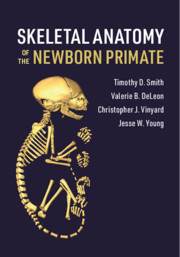Book contents
- Skeletal Anatomy of the Newborn Primate
- Skeletal Anatomy of the Newborn Primate
- Copyright page
- Contents
- Foreword
- Preface
- 1 Introduction
- 2 Primate Development and Growth
- 3 Why Ontogeny Matters
- 4 The Skull
- 5 Dentition
- 6 The Postcranial Axial Skeleton
- 7 The Pectoral Girdle and Forelimb Skeleton
- 8 The Pelvic Girdle and Hindlimb Skeleton
- 9 The Newborn Primate Body Form: Phylogenetic and Life-History Influences
- 10 Ontogeny of Feeding
- 11 Ontogeny of Locomotion
- References
- Index
- Atlas
9 - The Newborn Primate Body Form: Phylogenetic and Life-History Influences
Published online by Cambridge University Press: 23 March 2020
- Skeletal Anatomy of the Newborn Primate
- Skeletal Anatomy of the Newborn Primate
- Copyright page
- Contents
- Foreword
- Preface
- 1 Introduction
- 2 Primate Development and Growth
- 3 Why Ontogeny Matters
- 4 The Skull
- 5 Dentition
- 6 The Postcranial Axial Skeleton
- 7 The Pectoral Girdle and Forelimb Skeleton
- 8 The Pelvic Girdle and Hindlimb Skeleton
- 9 The Newborn Primate Body Form: Phylogenetic and Life-History Influences
- 10 Ontogeny of Feeding
- 11 Ontogeny of Locomotion
- References
- Index
- Atlas
Summary
Life-history theory pertains to the entirety of prenatal and postnatal ontogeny, and therefore morphology of the newborn offers an important perspective on how primates invest in their young. Generally, longer gestations yield larger neonates that are weaned later, become sexually mature later, and have larger brain masses. But can the variations in skeletal maturity are birth explained by life-history traits? Here, we examine new somatic data on 47 species of primates in light of life-history traits and modularity of growth among body regions. “Snout” length is uniformly diminutive in newborns compared to adults, although some scaling differences are already apparent at birth (relatively longer palates in strepsirrhines and tarsiers). Correlations of life-history characteristics indicate gestational length has a significant influence on facial functional matrices, with a positive correlation with permanent tooth and eye size, and a negative correlation with deciduous tooth germ size. We may as yet lack a broad enough perspective on brain size at birth, but some existing observations suggest primates preferentially prioritize prenatal brain growth over general somatic growth.
Keywords
- Type
- Chapter
- Information
- Skeletal Anatomy of the Newborn Primate , pp. 220 - 234Publisher: Cambridge University PressPrint publication year: 2020

